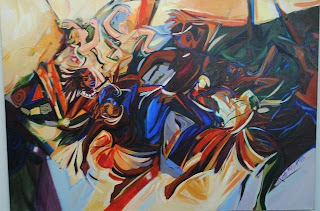One of the most violent moments of the civil rights era occurred in Montgomery 50 years ago and today Alabama State University is unveiling a series of artistic depictions of what happened on May 20, 1961.
On that day, civil rights activists dubbed “Freedom Riders,” were attacked at Montgomery’s Greyhound Bus Station where angry whites assaulted them with baseball bats, chains, fists and whatever else they could get their hands on.
Local authorities were virtually non-existent during the attack, and the activists were saved from further beatings by Alabama Public Safety Director Floyd Mann who withdrew his gun and waded into the mob until the violence stopped.
Books have been written and documentaries have been shown on television about the incident, but ASU is presenting something unique today — an artistic look at what occurred at the bus station half a century ago.
Presented by the National Center for the Study of Civil Rights and African-American Culture, the paintings will have their debut this afternoon from 3 to 5 p.m. at the facility at 1345 Carter Hill Road. The exhibit continues through May 31.
The exhibition, titled: “No Crystal Stair: A Climb to Freedom,” features works by Arthur Bacon, Ricky Calloway, Marcella Muhammad, Lee Ransaw and Charlotte Riley-Webb.
Presented in vivid colors, the paintings depict the violence, the anger and the sorrow that resulted from a seminal moment in America’s civil rights movement.
“The pieces in the exhibit honor the gallant contributors to African-Americans’ struggle for freedom by the Freedom Rides and by others who sought to force the nation to live up to its creed of justice and equality for all regardless of race,” ASU spokesman Ken Mullinax said.
ASU graduate student Rolundus Rice, who is helping to promote the exhibit, said Saturday afternoon that it is one of several events that will be presented during the 50th anniversary of the bus station violence.
“These artists present a vivid, clear voice to what happened that day,” he said. “It further galvanized public support for the movement, and we are pleased to invite the public to join us.”
The riders were testing federal edicts prohibiting segregated bus seating and services in the South. The beatings they took woke the nation to incidents that only grew worse as the 1960s progressed.
Assassinations of civil rights leaders including Dr. Martin Luther King Jr. and Medgar Evers and the murders of three civil rights activists in Alabama and Mississippi led to arrests of Ku Klux Klansmen who were responsible.
“I vividly remember the tumultuous times that led to the riots during the ’60s, the demand for equality and legislative changes that many take for granted today,” said Riley-Webb, who plans to be at the exhibit today.
After years of delays, the Greyhound Bus Station where the violence occurred is slowly being turned into a museum at 210 S. Court St.
A panel depicting various aspects of the incident at the bus station was unveiled a few years ago and work is continuing on the interior.
The building is owned by the U.S. General Services Administration while the Alabama Historical Commission has the lease and is working with local groups to help commemorate the event.

